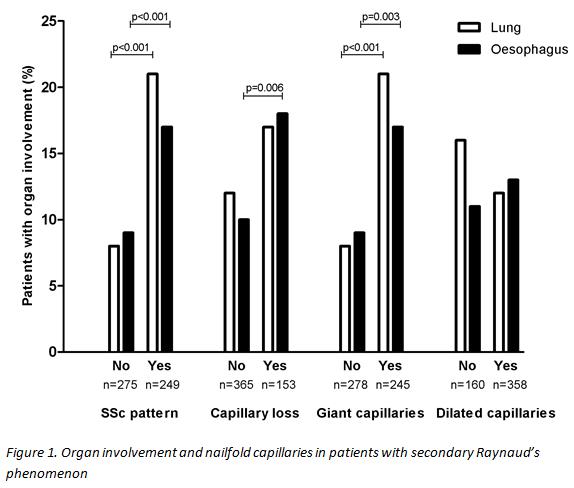Session Information
Session Type: ACR Poster Session B
Session Time: 9:00AM-11:00AM
Background/Purpose: RP is a common symptom of CTD. Nailfold capillary microscopy (NCM) has previously been shown to be associated with disease severity and internal organ involvement in relatively small non-consecutive cohorts. NCM may help in early recognition and awareness of (SSc like) internal organ involvement. It is unclear to which extent NCM abnormalities occur in several CTDs and whether these are associated with organ involvement. We evaluated consecutive patients visiting the vascular lab for NCM.
Methods: NCM was retrospectively assessed in consecutive patients with suspected RP (n=961) between 2008 and 2013 according to standardized procedures at our center. In 25 patients NCM was not assessable, in 177 RP was not present after careful chart review. Patients were classified as primary RP (normal NCM and ANA <1:80, n=235) or secondary RP, comprising very early diagnosis of SSc (VEDOSS, n=203), SSc according to ACR/EULAR criteria (n=39), SS according to American European Consensus Group criteria (n=37), SLE according to SLICC criteria (n=22), MCTD based on criteria defined by Kasuwaka (n=7) or when not meeting criteria as no classifiable disease (n=216). NCM was classified as normal, non-specific (≥3 dilated capillaries per finger) or SSc pattern: early, active or late. Giant capillaries were abnormal per definition, capillary loss was defined <20 capillaries per 3 mm. Pulmonary involvement was defined as forced vital capacity or diffusion capacity <70%, interstitial lung disease on HRCT and/or pulmonary arterial hypertension. Gastro-intestinal involvement was defined as scintigraphically (Tc-99M colloid) abnormal oesophagus motility.
Results: SSc pattern was observed in 32% of patients with SS , 31% SLE and 85% MCTD (table 1). Organ involvement was more frequent in secondary RP patients with a SSc pattern (figure 1). When analyzing patients fulfilling criteria for CTD separately this relation still existed (pulmonary 21 versus 8%; oesophageal 17 versus 9%), even after exclusion of VEDOSS and SSc patients. Also, in patients with giant capillaries pulmonary and oesophageal involvement was more frequent, while no relation was found for dilated capillaries. Capillary loss was associated with oesophageal involvement only.
Conclusion: SSc-like NCM pattern is common in CTD patients and appears to be associated with a greater prevalence of organ involvement, even in the absence of VEDOSS and SSc. Although this was a retrospective cohort, these data underline the importance of assessing NCM in RP patients to evaluate the risk for organ involvement in CTD other than SSc, already in early stages of the disease.
To cite this abstract in AMA style:
van Roon AM, Huisman CC, van Roon AM, Stel AJ, Smit AJ, Bootsma H, Mulder DJ. An Abnormal Nailfold Capillaroscopy Pattern Is Common in Patients with Connective Tissue Disease and Is Associated with Pulmonary and Oesophageal Involvement, Even in the Absence of Systemic Sclerosis [abstract]. Arthritis Rheumatol. 2016; 68 (suppl 10). https://acrabstracts.org/abstract/an-abnormal-nailfold-capillaroscopy-pattern-is-common-in-patients-with-connective-tissue-disease-and-is-associated-with-pulmonary-and-oesophageal-involvement-even-in-the-absence-of-systemic-sclerosis/. Accessed .« Back to 2016 ACR/ARHP Annual Meeting
ACR Meeting Abstracts - https://acrabstracts.org/abstract/an-abnormal-nailfold-capillaroscopy-pattern-is-common-in-patients-with-connective-tissue-disease-and-is-associated-with-pulmonary-and-oesophageal-involvement-even-in-the-absence-of-systemic-sclerosis/


